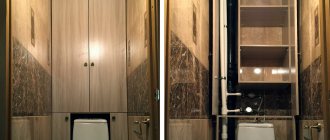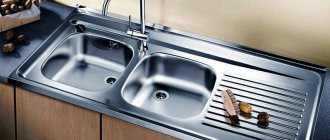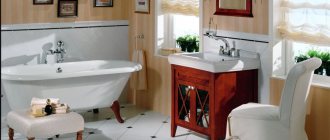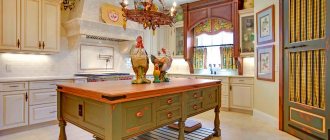Connecting a hygienic showerInstalling a hygienic shower in the toilet
Installing a hygienic shower is a good alternative to a bidet. If you do not have the opportunity to install a bidet in the bathroom, but there is a need for it, then installing a hygienic shower will be the way out. The device is compact, but no less convenient. A hygienic shower differs from a regular shower in the size of the shower head and in that it is made of a special material coated with chrome, which does not allow the accumulation of dirt and dust.
Hygienic shower is divided into the following categories:
1) Installation of a hygienic shower in the seat - toilet lid; 2) Installation of a hygienic shower built into the toilet; 3) Hygienic shower installed next to the toilet on the sink; 4) Installation of a hygienic shower using a mixer (external or built into the wall);
The most common among our consumers is a shower connected to a sink or shower mixer (if there is no sink). This is due to the fairly inexpensive price and variety of models presented on the market of plumbing equipment. The hygienic shower includes: a watering can, a hose and a mixer. If you do not have the opportunity to install a sink in the toilet room, then you should use a faucet with a hygienic shower without a spout.
When you open the shower, water will immediately flow into the hose and watering can. On the watering can itself there is a special valve, when pressed, water begins to flow, and when you release it, the water stops flowing
It is very important to remember that after taking hygiene procedures, the tap must be closed, otherwise it will end in a flood. If you have a sink, you will need a faucet with a spout that has an outlet for connecting a shower.
By opening the faucet, water will flow into the sink, and by pressing the valve, water will flow from the watering can. Installing a hygienic shower significantly saves space, which is very important for small toilet rooms.
A hygienic shower can be installed in the toilet room at any time without resorting to renovation of the bathroom. The hygienic shower is connected to existing communications. Water is connected both from the sink and from the hot and cold water risers, as well as the water supply passing through the toilet room. Experienced plumbers advise purchasing a wall-mounted hygienic shower with an open installation method.
The advantages of a hygienic shower are that you do not need to move from place to place (as is the case with a bidet) and there is significant space saving. Some people believe that installing a hygienic shower is not necessary, but if several people live in an apartment, then a hygienic shower is a good alternative to a bathroom.
In any case, an experienced plumber will always tell you which of the hygienic shower options is right for your toilet room.
Design features of a hygienic shower
The functionality of a hygienic shower is determined by the presence of the following design elements:
- The connecting unit of the device with the hot and cold water supply pipeline.
- A mixer used to obtain the optimal outlet water temperature.
- Control knobs - a special block, installed at a height of 60-80 cm from the floor level for greater convenience. The exact value is selected based on data on physiological characteristics, user preferences, and the level of installation of the toilet seat.
- Shower heads fixed to the wall surface using a special clamp. Height is determined by the individual structural features of the human body.
- A flexible hose of a certain length, selected depending on actual needs.
Some models of hygienic showers are equipped with built-in electronics of various modifications, which makes using the device even more convenient. Premium models are complemented by a special electronic display that allows you to control the system in 1 click. However, when installing such a model in the bathroom, you will first have to understand the remote control in order to understand how to use the hygienic shower. The photo illustrates an example of remote control of the system.
Recommendations for selection
Plumbing and sanitary ware stores offer almost all types of hygienic showers. All that remains is small: choose the type of shower, material of manufacture, design and quality. When purchasing a device, consider the following features:
Device design. Some models do not allow connecting to two pipes at the same time, then the output is only cold water. Method of attachment. Sometimes, when mounted on a wall, residual drops are found on the shower head that flow onto the floor Product material
Give preference to brass with a chrome-plated surface, this option is the most durable in use. Study the demand on the market, always choose the price-quality ratio, and pay attention to the warranty and service.
Budget models are made from silumin and plastic
Video description
You can watch this video about whether you need a hygienic shower and what to look for when choosing one:
When choosing a device, you must pay attention to the material of manufacture. The ideal option would be chrome-plated brass or stainless steel with ceramic inside. Bronze products will be more expensive. But silumin ones are cheap, but not reliable. It is best to purchase products with a quality guarantee. Their selection is very large, and prices generally range from 1 to 15 thousand rubles.
What does a hygienic shower consist of?
The purpose of a hygienic shower is clear to everyone. It is necessary for washing intimate places in order to maintain personal hygiene. Since it will be used frequently, the design of this equipment must be approached with the utmost seriousness.
A hygienic shower consists of the following elements:
- mixer without spout (single-lever or double-lever);
- watering cans;
- flexible hose;
- holder for watering can.
Some sources consider a bidet or a toilet with a bidet function as a hygienic shower. However, this does not seem correct. A bidet and a toilet with a bidet function are independent sanitary equipment that allows you to perform personal hygiene procedures.
A shower, whether hygienic or otherwise, requires a watering can, a flexible hose and a mixer. Only such a set of equipment can be called a “shower”. Therefore, it is this that is considered further.
But there are also faucets that are installed directly into the toilet lid. These designs always provide one of two possible control methods: manual or electronic. Models of the second type are more modern and more expensive. A hygienic shower for a toilet with a mixer can be purchased separately and installed independently.
Mixing water
The release of hot water is a common problem for those in whose home a hygienic shower for washing is mounted on the toilet, namely due to ignorance of the operating rules and forgetfulness of the owners.
The outer part of the hygienic shower looks like a watering can with a hose coming out of the wall. Inside, this structure is connected to the plumbing system through a hot and cold water mixer.
The switch lever is placed near the toilet, and in the “on” position, water flows into a flexible hose and reaches a spray head equipped with a button with a mixed water supply valve. Further use of the shower is carried out according to the scheme described below and is not difficult.
Multifunctional wall hung toilets
Floor-standing toilets, to which most consumers are accustomed, are gradually being replaced by wall-hung models. The unusual design and obvious advantages when cleaning the bathroom are appreciated by an increasing number of buyers. Manufacturers offer owners of apartments with small bathrooms to install wall-hung toilets complete with a hygienic shower connected to an installation that provides a water supply to the mixer.
In the false wall covering the metal frame of the installation, there is space for installing a watering can holder and a mixer, to which hot and cold water is supplied. All communications are hidden behind a false wall, thereby increasing the attractiveness of the bathroom interior. Installation of a wall-hung toilet is carried out on your own according to the instructions supplied by the manufacturer of the sanitary ware, or you can invite a specialist plumber.
As you can see, there is nothing complicated about installing a hygienic shower for a toilet. The progress of installation work depends on the characteristics of the purchased equipment model. When installing this device, you need the same tools as for installing other types of plumbing fixtures.
What happens when the shower is used incorrectly
Forgetting the last of the points described above, the following happens. Compared to cold water, hot water moves under greater pressure through the mixer, which is not blocked by the shut-off lever through the cold water pipe. As a result, cold water is completely forced out of the pipes and fills the system with hot water for all neighbors. Then the search begins for the possible cause of this phenomenon, and the whole point lies in simply turning the lever to the “closed” position.
Studying such a simple design as a hygienic shower for a toilet and how to use the device will help you avoid possible problems in the future, not harm yourself and prevent conflict with neighbors and housing and communal services workers.
Types of products
Today's market for hygienic shower models is represented by several options. Each of them has its own characteristics and application features. The water connection can be hidden in the wall, or located in a visible place. In this case, built-in models imply some kind of repair if the device breaks down.
The design of the device is simple and in order to use it, you just need to press the button located on the watering can, first opening the mixer valve.
If the watering can has a thermostat, then the temperature is set only once, and subsequently it remains the same as it was set. In this case, the shower system will remember the desired temperature and will output it every time the shower is turned on.
In order not to bother yourself with repairs, in the process of connecting water to the mixer, simply lay the necessary pipe by connecting it to the nearest plumbing fixture.
The holder and watering can in the wall-mounted device are connected by a flexible hose.
Hygienic shower with sink. If the bathroom requires a sink next to the toilet, then you need to choose a faucet equipped with a third water outlet. Then, if necessary, water will be supplied to the shower head. This device works like this: when the tap is opened, water is supplied to the nose of the mixer and held there until the control button is pressed. As soon as the button is pressed, the water flows to the hygienic shower head. This shower model will fit perfectly into a small or combined bathroom. A variety of product options allows you to attach the shower head directly to the sink. And if the bathroom is very small, you should try choosing a sink with a corner placement, which is installed above the toilet cistern. This move will save additional space in the room.
Such devices are equipped with a built-in mixer, in which the control lever is mounted on top of the device or on the side
Installation of this type of hygienic shower is quite easy and is equivalent to installing a regular sink. The main design feature: a mixer with a third outlet. After using the tap, do not forget that it is necessary to turn off the mixer, otherwise water from it will flow into the sink.
Bidet toilet. This is a multifunctional device that in appearance resembles a standard toilet, but is equipped with a special nozzle for supplying water. The nozzle must be retractable and have a power button. It is usually located on the rim of the toilet. The water supply to the mixer in such devices is connected to the installation from below through a separate hose.
Such a universal device is good because it can be used both in regular toilets and in wall-hung ones, which significantly saves space in the bathroom. The design of the installation itself is a metal frame onto which the bowl is attached. By pressing the button on the toilet, the nozzle extends and supplies water at the desired temperature. At the end of use, the nozzle hides in its place. The pipes to this toilet-bidet are installed behind a false wall. The model is compact, but has a high cost, which depends on the set of additional functions and the manufacturer.
Bidet lid. Another option for a hygienic shower. Such a lid has a certain set of functions, which may include heating water to the desired temperature. The toilet lid is portable. It is equipped with control buttons that allow you to select one or another function. The lid itself is connected to the sink or to a tee, which is responsible for supplying water to the drain tank.
Bidet lids can be mechanical or electronic. The latter option is mains powered, is more expensive and may have additional features. However, in the absence of electricity, the possibility of using a bidet lid is reduced to zero, due to the fact that water heating will be carried out from the power supply.
The variety of models allows you to choose exactly the option that is most suitable for the bathroom with certain conditions.
Design Features
The appearance of the hygienic device is practically no different from the well-known standard shower. Both of them consist of:
- mixer;
- flexible hose;
- watering cans.
But the purpose of the device still causes some differences. There is no need for a large, diffuse stream of water, so select a small-sized mixer with a focused, gentle flow without splashing.
Some models of such showers are equipped with a thermostat to automatically regulate the comfortable temperature of the water stream. Once the thermostat is adjusted immediately after installing the shower, it will ensure that the set temperature is maintained throughout its entire lifespan.
A type of hygienic shower for the toilet Source ozonsanteh.ru
This element will protect you from possible unpleasant sensations when coming into contact with too hot or cold water.
The main difference is that the water from the switched-on hygienic shower does not flow until a special flow control button is pressed, and the pressure is adjusted using a special mixer lever.
Options for installing a hygienic shower in a toilet
You need to think about how a hygienic shower in the toilet will be arranged at the stage of laying pipes (if this is a new building) and choosing a place to install it (if this is a used home). There are three options for installing a hygienic shower:
- Open.
- Closed.
- Connection to the sink.
Second: a hygienic shower with a hidden-mounted thermostat, the most complex, as it requires cutting the wall and laying pipes in the appropriate recesses. The first one is simpler in connection technology, but less attractive from an aesthetic point of view.
However, it is most often chosen when installing hygienic equipment in already inhabited premises. Not wanting to destroy the external tile finish, the owners simply extend the pipes to the desired location and connect the mixer to them. If desired, the installation site can be masked using a plasterboard box.
Therefore, how to connect a hygienic shower in the toilet is chosen based on various considerations:
- practicality;
- efficiency;
- installation speed;
- ease of use.
Sink connection
Installing a hygienic shower in a toilet by connecting it to a sink is both simple and complicated at the same time. It all depends on how open access is to the pipes of the water supply system and whether the toilet already has a working sink.
If there is none, it is installed simultaneously with a hygienic shower as follows:
- choose a place for the sink and watering can, mark it on the wall;
- determine how the pipes will be laid and make grooves in these places;
- lay the pipes so that there are two connection points: hot and cold water;
- determine the location of the sink and install it;
- cover the grooves with cement-sand mortar, plaster mixture or tile adhesive;
- connect the sink outlet to the sewerage system;
- install a faucet on the sink, which should have a separate outlet for connecting a flexible hose;
- connect a flexible hose to the mixer;
- in a predetermined place, holes are drilled on the wall to install the watering can holder;
- install the holder;
- connect the watering can to a flexible hose and install it in the holder.
But not every toilet in modern apartments has enough space to install a sink. For this reason, other options for creating a hygienic shower are used.
Connection to an existing water supply system
In used toilets, water and sewer pipes are hidden by building plasterboard boxes. To install a hygienic shower, this external protection will have to be dismantled. Then proceed as follows:
- turn off the taps that regulate the supply of hot and cold water;
- select the insertion points for the tees and install them;
- choose a method for laying pipes and install them, having previously connected them to the tees;
- wrap the threaded connections of the mixer with plumbing linen and/or fluoroplastic fum tape;
- install the mixer;
- connect a flexible hose to it;
- install the holder on the wall;
- connect a flexible hose to a watering can.
In this installation method, the main difficulty will be the installation of pipes. They can be laid open or closed
But regardless of the installation option, special attention is paid to the tightness of the connections
Instead of two tees, you can install only one: on the hot water pipe. And connect to cold water from the outlet to the toilet. Sometimes this installation will be most convenient. The connection option is selected based on the characteristics of pipe routing and plumbing connections in a particular room.
If you take your time and carefully consider every step, installing a hygienic shower in the toilet will not cause any particular difficulties. Properly installed equipment will serve well for many years.
Video description
Installing a hygienic shower in a toilet with polypropylene soldering:
First, you need to turn off the water supply and make pipe routing, preferably with the least number of turns.
If you have a thermostat, you should carefully approach the issue of connecting the water so as not to confuse the cold and hot pipes. The first is usually located on the right, and the second on the left. Then you should install pipes under the mixer, matching the distance with the holes of the mixer and thermostat.
After this, the wall is walled up and plastered, and then a hose with a mixer is connected. The nuts should be tightened as tightly as possible, but without over-tightening.
It is recommended to use anchor bolts to secure the holder to the wall. You should start by drilling holes for the dowel. A hole depth of 6 cm with a diameter of 6 mm will be sufficient. Then you need to insert the dowels and secure the clamp with anchors. The height of the hygienic shower from the floor should be as convenient as possible for its use by the shortest member of the family. This method is simple and reliable.
An example of placing a hygienic shower with size markings Source pinimg.com
After completing the installation, you should configure and check the operation of the hygienic shower. The pressure is turned on and the product is checked for leaks. A comfortable water temperature is checked and adjusted, and then its supply is shut off. It is recommended to turn off the water supply to the faucet after using the shower to reduce the effect of pressure on the control valve.
Installation of a hygienic shower
It is not enough to simply purchase a plumbing fixture. It still needs to be installed correctly in its place.
It is extremely important to do this correctly, because the comfort of its use depends on it. Let's look at ways to install various options for a hygienic shower
Installation of a wall-mounted shower
A high-quality installation of a shower on the wall can decorate a bathroom, especially if you choose the device in the same style as the design of the room. Wall mounting can be carried out in two ways - open and closed.
Open installation is simpler, as it does not require any dirty work. The mixer is mounted on the wall using anchors or dowels, using a drill. A holder for a watering can is screwed next to the mixer.
Installing a hygienic shower in a toilet using a closed method involves installing a special recess in the wall in which the mixer will be hidden. Only the control lever and the holder with the watering can will remain visible.
Wall-hung toilet with hygienic shower - example of a closed installation
In any case, it is necessary to bring water supply pipes inside or outside the wall to the mixer and connect them. Often a thermostat is built into such a system, which is also mounted on the wall.
Installing a faucet on a sink
When the bathroom has a sink, running a hygienic shower for the toilet from it is not a difficult task. First you need to decide on the type of faucet on the sink. If it is already installed, then you may not need to purchase a new device. A prerequisite is the presence of a specially shaped watering can designed for hygiene procedures.
If you don’t have a mixer yet, then buy exactly the same mixer as described above. Its installation is not difficult. The flexible hose must reach the toilet freely. It usually works in conjunction with the spout. When the tap is open, water flows into the spout, and when you press a button on the shower, water flows into a flexible hose.
Shower built into the toilet
When a toilet with a hygienic shower (bidet toilet) is installed in a room, the old toilet must first be dismantled. A new device is installed in its place and attached to the floor or wall. In the new room, the toilet is immediately installed in a permanent place.
When a built-in hygienic shower in a toilet is connected, the connection diagram looks like this:
- water hoses are connected to the mixer;
- the mixer is inserted into the existing hole and secured there;
- the ends of the hoses are screwed onto the water pipes;
- the shower and the operation of the mixer are tested;
- If a retractable nozzle is used, its operation is checked.
Installation of the bidet cover
This work can be easily carried out independently, since it does not involve violating the integrity of the walls or inserting into the plumbing system. It is enough to purchase a tee that will be installed next to the toilet cistern.
Bidet lid installation diagram
Do-it-yourself installation of this type of hygienic shower in a toilet is carried out in the following sequence:
- the old lid is removed from the toilet, and a bidet lid is attached in its place;
- the water in the system is shut off;
- the tank is completely drained;
- the supply hose is unscrewed, through which water flows into the tank;
- A tee is installed between the water pipe and the tank. One end of the tee goes into the tank, and the second is connected to the toilet lid;
- If the device is controlled by an electric drive, then it is connected to a specially designed socket for this purpose.
When buying a hygienic shower for a toilet, try to focus not only on the price, but also on well-known manufacturers who specialize in producing such accessories. Thus, you will provide yourself with high-quality equipment, the purchase of which you will not regret.
Types and features
There are several types of hygienic showers, which differ in their design, location and capabilities. Let's list them.
Toilet with bidet function
This is the most convenient option, in which the toilet is equipped with a retractable nozzle. The mixer is installed separately or built into the toilet. The water flow is controlled manually.
Toilet with bidet function and hygienic shower
Wall mounted shower
If preference is given to a wall-mounted shower option, then purchase a special mixer for this that does not have a spout . Water will exit only through a flexible hose. The mixer for a hygienic shower in the toilet is mounted on the wall or built into it. A holder is also attached next to the mixer, into which the watering can is inserted.
Wall-mounted hygienic shower with thermostat
Mounted on the sink
If there is a sink in the bathroom, not far from the toilet, then it makes sense to install a hygienic shower directly on it. It will be controlled using a mixer that has an outlet for a flexible hose. In this case, you will not have to purchase a special bidet toilet, since you will always be able to reach from the toilet to the sink and use a flexible hose.
Option for placing a shower for a toilet on a sink
Built into the toilet lid
A built-in hygienic shower for a toilet can be built into its lid. A huge advantage of such a device is that it can be installed on any toilet. That is, this device is mobile. It can be removed and reinstalled on the toilet in another room. The lid is equipped with retractable nozzles made of antiseptic materials.
Bidet lid
The bidet lid can be controlled manually or using an electric drive with a control panel. More advanced models can be equipped with the functions of a hair dryer, water heating and a seat.
Tips for choosing and reviews from the owner of a hygienic shower are presented in the video.
Connecting a hygienic shower to a sink
If there is a sink in the toilet, you can connect a hygienic shower to its faucet. True, in this case you will have to replace the already installed mixer with a special model, equipped with a third outlet of mixed water to a hygienic watering can.
This equipment works on the following principle:
- when you turn the handle of a single-lever mixer, water rushes into the sink through the spout (spout) and into the hose of the hygienic shower, which is held in by a shut-off valve;
- When you press the button on the handle, water begins to flow from the shower head, but at the same time stops flowing from the mixer spout.
The location and height of installation of the hygienic shower head holder is selected so that it is convenient for a person to use this plumbing device. The holder can be attached near the sink or near the toilet. When purchasing mixing equipment, pay attention to the length of the watering can hose, especially if the sink is located at a considerable distance from the toilet. Here is a clear example of how to choose a suitable location for mounting the unit:
You can increase the functionality of the equipment installed in the toilet in a couple of hours. After all, you just need to replace the mixer, which is already connected to existing communications. You don’t even have to wait for the start of cosmetic or major repairs to the premises.
If there is no sink in the bathroom, then plumbers recommend installing one by choosing a small corner model. In this case, all necessary hygiene procedures can be carried out without leaving the toilet room. This is true for separate bathrooms.
Why you should choose a hygienic shower for the toilet
The hygienic shower is still new to us, but in Finland they have been familiar with this device and how to use the hygienic shower for more than 30 years. It is used for washing after urination or defecation. This shower system is easy to install near the toilet, which makes using the device easier. Owners of houses and apartments, and more, have already checked whether it is convenient to use a hygienic shower. The practice of using the design has also taken root in public places, so a toilet with such a shower in a cafe, train station, educational institution, etc. is no longer surprising.
Striving for greater comfort, this trend came to the inhabitants of the Eurasian continent, although it is believed that the Japanese were the pioneers of the hygienic shower.
The Russians quickly picked up the new trend in plumbing and checked that installing a bidet in a bathroom or toilet room is not at all necessary. Although, it is worth noting that we have not yet figured out how to use a hygienic shower. Useful space can be saved without compromising the comfort and functionality of the room by installing a hygienic shower. In addition, such a device will be cheaper. Using the system is already commonplace, and every year more and more people who are renovating their home or apartment choose an alternative and more profitable option than a bidet.
Main varieties
There are 4 types of hygienic shower designs:
- bidet cover;
- shower toilet;
- shower connected to the sink;
- wall-mounted shower.
Bidet lid
Electronic bidet cover.
This type of design is a mixture of a classic bidet and a toilet. It was designed to save space in bathrooms. The design is built into the toilet lid and controlled via a special panel or remote control. The device is connected to the pipeline supplying water to the toilet tank.
Electronic bidet covers perform the following functions:
- The water is heated using an electric heater.
- Most models are equipped with a hairdryer, which acts as a dryer.
- Turns on and off automatically.
- Using liquid that fills a special container, it flushes the nozzles and the toilet, i.e., it performs a sanitary function.
Bidet lid for toilet.
Shower toilet
The only difference between a shower toilet and a regular one is that the tank of the former has large dimensions, since all the electronics are built into it.
Depending on the model, it has the following features:
- The nozzle can be retractable or stationary.
- You can select the jet type and intensity of the water flow.
- Disinfects the surface of the toilet bowl with a special solution.
- There is a water heater and water temperature control.
- Hairdryer available.
Under-sink shower
Sink mixer with hygienic shower.
The shower and sink share one faucet. Installation is simple, but you will need to purchase a device with three connections: for spouting into the washbasin, connecting to the water supply and connecting the hygienic shower hose. When you turn the faucet handle on the mixer, water comes out of it over the washbasin. But as soon as you press the button on the shower head, the liquid stops going into the sink and goes into the shower head. If you release the button, water will flow over the washbasin again.
This design has the following advantages:
- The temperature can be adjusted over the sink.
- After releasing the button on the watering can, residual water will not flow onto the floor.
- It's inexpensive.
Faucet with hygienic shower.
Wall-mounted design
This type of hygienic shower is connected to the water supply network. The design consists of a mixer equipped with temperature control valves, a hose and a watering can attached to the wall using a holder. Of all the options, this is the most convenient and easiest in technical terms, since installation can be done independently; you can use ready-made connection diagrams.











